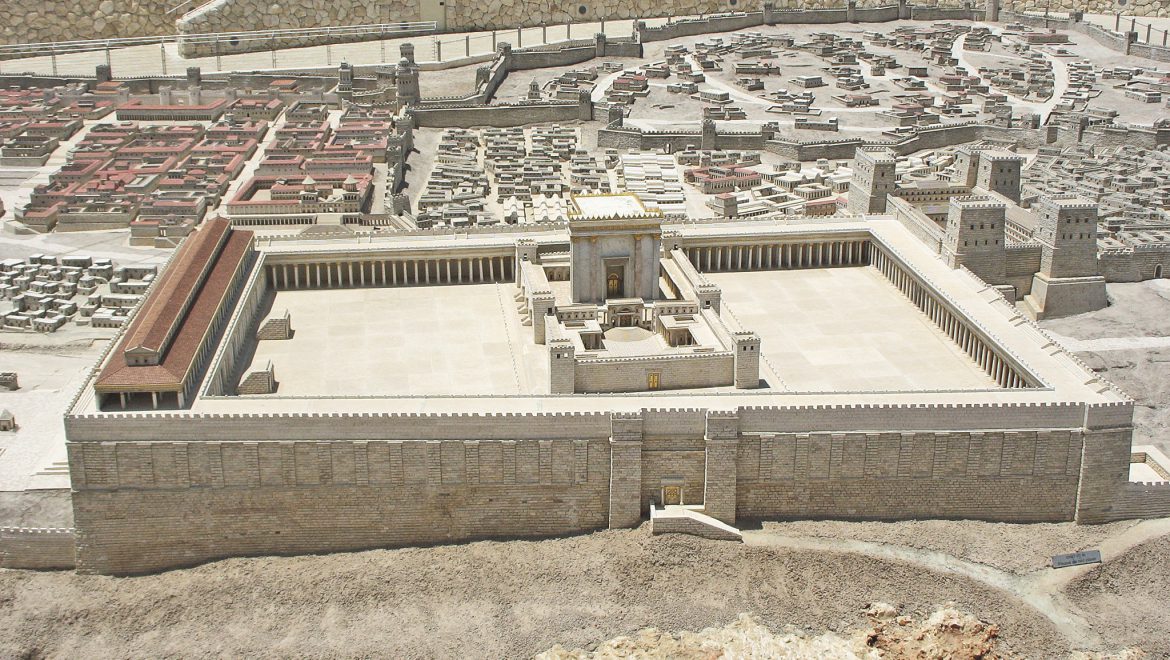
Written by Rabbi Mendy Hecht for AskMoses.com, this thorough article describes the physical structure of the First and Second Temples, as well as their spiritual significance and centrality to Jewish life and worship during temple times. Toward the end of the article, the author suggests his own explanation for the divine purpose of the destruction of the Temples, and how this has impacted Jewish spirituality in our times.
What Was the Holy Temple?
The Structure
The “Holy Temple”—in Hebrew, Beit Hamikdash (pronounced BAYt hah-mik-DAHS)—was a large (approximately football-stadium-sized), multi-level, indoor-outdoor structure that was the nucleus of Judaism, its most sacred site. It stood atop Jerusalem’s Mount Moriah.The first Beit Hamikdash was built by King Solomon in the year 833 BCE, and destroyed by the Babylonian king Nebuchadnezzar in the year 423 BCE. The second Beit Hamikdash was completed in the year 349 BCE by Jewish returnees from the Persian exile, led by Ezra and Nehemiah. In the year 19 BCE, King Herod completed dramatic renovations to the dilapidated Temple, but marauding armies of the Roman Empire destroyed it in 69 CE, when the current galut (exile) began.
Very little architectural data about the first Beit Hamikdash has survived, unlike the second, about which much was recorded. Both consisted of a tall, majestic, ornate and geometric hall (heichal) surrounded by sweeping, stepped courtyards and castle-like stone walls. The outermost walls described a rectangle from a bird’s-eye view, within which were the stepped courtyards and the hall in the upper center. Within its wide courtyards were vast outdoor floor spaces for the thousands of pilgrims attending the tri-annual holiday services (Passover, Shavuot and Sukkot), a mighty altar where thousands of animals and birds were brought as offerings, and storage and staff facilities for the hundreds of on-duty kohanim (priests) and Levites (who assisted the kohanim).
The hall housed a small incense altar, a ceremonial bread rack, a menorah, and the Holy of Holies—a small square room at the back of the hall formed by a wall-to-wall cloth partition, behind which was stored the Ark of the Covenant. The Holy of Holies was a space so ethereal that the laws of physics were suspended within its confines. It was entered only by the high priest, the most spiritual human being, on Yom Kippur, the most spiritual day of the year.
The Temple’s centrality to Jewish existence is reflected in the fact that many of the mitzvot are Temple-related: daily and weekly offerings; holiday pilgrimages and offerings; personal, voluntary and obligatory offerings; agricultural tithes; qualifying criteria for the Kohanim and Levites; Temple rituals; and the dos and don’ts for all of the above. We’re talking around 180 mitzvot (out of a total of 613).
What was/is the significance of the Temple?
The Confused Temple
The problem with the word “temple” is that Indiana Jones got to it. Today, whenever I say “temple,” I guarantee you’ll picture jungle, torches, hieroglyphics, dark foreboding stone entranceways; jungle, dark foreboding stone entranceways overgrown with jungle, illuminated by torches and inscribed with hieroglyphics; jungle, terrifying supernatural forces; and more jungle. And don’t forget rats, skulls, firepits and the occasional mummy. And jungle.
The Real Temple
With the jungle of pop-culture temple jingoism slashed and burned out of the way, let’s talk G‑d’s take on temples.
You didn’t have to be Jewish to go to the Temple; kings and peasants from every country and culture traveled long distances just to experience it all. The Temple was the single most important structure in society, offering structure to society. Then it was destroyed.
The Final Temple
If the times of the Temple were principally G‑d reaching down to His world, then the times of our exile are us reaching up, from within that world.
This is G‑d’s master plan. First, a sweeping, dramatic outdoor concert of public spirituality, reaching viscerally and tangibly into the everyday, physical reality. Then He exchanges this for an internal, personal, private experience, forcing us to reach up to find Him, bringing the entire Creation along with us. Together, the two experiences lay the groundwork for the third and final Temple—an age that will synthesize both directions of spirituality. An age of where G‑d’s presence inside our hearts and minds and in the physical world is internalized to achieve a whole new reality: the era of Moshiach.

